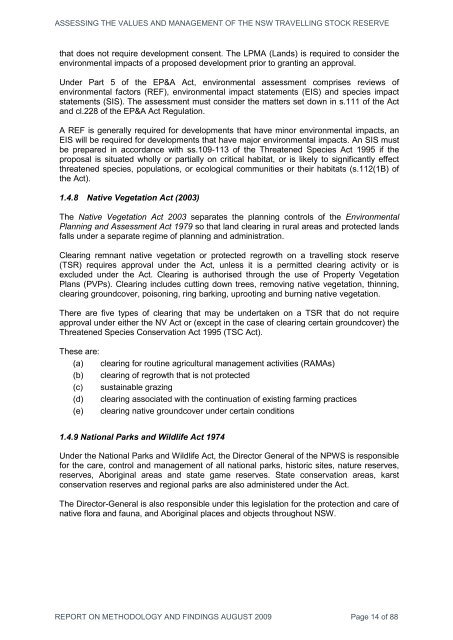Assessing e Values and Management of the NSW Travelling ... - Land
Assessing e Values and Management of the NSW Travelling ... - Land
Assessing e Values and Management of the NSW Travelling ... - Land
You also want an ePaper? Increase the reach of your titles
YUMPU automatically turns print PDFs into web optimized ePapers that Google loves.
ASSESSING THE VALUES AND MANAGEMENT OF THE <strong>NSW</strong> TRAVELLING STOCK RESERVE<br />
that does not require development consent. The LPMA (L<strong>and</strong>s) is required to consider <strong>the</strong><br />
environmental impacts <strong>of</strong> a proposed development prior to granting an approval.<br />
Under Part 5 <strong>of</strong> <strong>the</strong> EP&A Act, environmental assessment comprises reviews <strong>of</strong><br />
environmental factors (REF), environmental impact statements (EIS) <strong>and</strong> species impact<br />
statements (SIS). The assessment must consider <strong>the</strong> matters set down in s.111 <strong>of</strong> <strong>the</strong> Act<br />
<strong>and</strong> cl.228 <strong>of</strong> <strong>the</strong> EP&A Act Regulation.<br />
A REF is generally required for developments that have minor environmental impacts, an<br />
EIS will be required for developments that have major environmental impacts. An SIS must<br />
be prepared in accordance with ss.109-113 <strong>of</strong> <strong>the</strong> Threatened Species Act 1995 if <strong>the</strong><br />
proposal is situated wholly or partially on critical habitat, or is likely to significantly effect<br />
threatened species, populations, or ecological communities or <strong>the</strong>ir habitats (s.112(1B) <strong>of</strong><br />
<strong>the</strong> Act).<br />
1.4.8 Native Vegetation Act (2003)<br />
The Native Vegetation Act 2003 separates <strong>the</strong> planning controls <strong>of</strong> <strong>the</strong> Environmental<br />
Planning <strong>and</strong> Assessment Act 1979 so that l<strong>and</strong> clearing in rural areas <strong>and</strong> protected l<strong>and</strong>s<br />
falls under a separate regime <strong>of</strong> planning <strong>and</strong> administration.<br />
Clearing remnant native vegetation or protected regrowth on a travelling stock reserve<br />
(TSR) requires approval under <strong>the</strong> Act, unless it is a permitted clearing activity or is<br />
excluded under <strong>the</strong> Act. Clearing is authorised through <strong>the</strong> use <strong>of</strong> Property Vegetation<br />
Plans (PVPs). Clearing includes cutting down trees, removing native vegetation, thinning,<br />
clearing groundcover, poisoning, ring barking, uprooting <strong>and</strong> burning native vegetation.<br />
There are five types <strong>of</strong> clearing that may be undertaken on a TSR that do not require<br />
approval under ei<strong>the</strong>r <strong>the</strong> NV Act or (except in <strong>the</strong> case <strong>of</strong> clearing certain groundcover) <strong>the</strong><br />
Threatened Species Conservation Act 1995 (TSC Act).<br />
These are:<br />
(a) clearing for routine agricultural management activities (RAMAs)<br />
(b) clearing <strong>of</strong> regrowth that is not protected<br />
(c) sustainable grazing<br />
(d) clearing associated with <strong>the</strong> continuation <strong>of</strong> existing farming practices<br />
(e) clearing native groundcover under certain conditions<br />
1.4.9 National Parks <strong>and</strong> Wildlife Act 1974<br />
Under <strong>the</strong> National Parks <strong>and</strong> Wildlife Act, <strong>the</strong> Director General <strong>of</strong> <strong>the</strong> NPWS is responsible<br />
for <strong>the</strong> care, control <strong>and</strong> management <strong>of</strong> all national parks, historic sites, nature reserves,<br />
reserves, Aboriginal areas <strong>and</strong> state game reserves. State conservation areas, karst<br />
conservation reserves <strong>and</strong> regional parks are also administered under <strong>the</strong> Act.<br />
The Director-General is also responsible under this legislation for <strong>the</strong> protection <strong>and</strong> care <strong>of</strong><br />
native flora <strong>and</strong> fauna, <strong>and</strong> Aboriginal places <strong>and</strong> objects throughout <strong>NSW</strong>.<br />
REPORT ON METHODOLOGY AND FINDINGS AUGUST 2009 Page 14 <strong>of</strong> 88

















